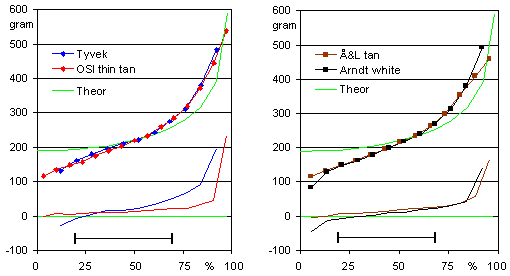 |
These result diagrams show the
weight read from the balance. The
horizontal axis is for bellows relative opening, where zero is when the
bellows is fully collapsed with suction applied. The various bellows
were covered at different times, with slight accidental width variation
in their cover strips. 100% indicates maximum opening without suction,
where the cover material is stretched essentially flat.
|
| Nominal working
range for the opening is typically 20 to 70 %, as indicated with
horizontal markers
above. The sketches at right are idealized views of the bellows, seen
from its short end. |

|
The
upper curves with markers are for the bellows with suction applied,
the lower ones without markers when the bellows is vented. The green
curves show theoretical force for an ideal cover material forming flat
hinged bellows ribs (http://www.mmdigest.com/Gallery/Tech/airbounc.htm#2).
With a soft cover as in the actual case, the folds rather take a
rounded shape. This explains some of the difference to the
measurements. Also stretching of the material contributes to a
difference.
|
The more
important result is indeed the lower curves without markers,
those that represent the spring action of the cover material. This much
reflects the subjective impression from exercising the bellows by hand.
How hard to flatten the bellows folds toward 0%, and how much to pull
to open up the bellows all the way. For this you need very little force
having a zephyr or OSI tan covering. Conversely, the Tyvek covered one
appears extremely stiff and rigid, to a degree you may feel it should
be out of question to use it. But when you restrict the view to the
limited 20-70% range of actual operation, then the difference between
the various covering materials is relatively insignificant.
|
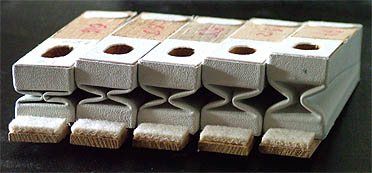 In one of the skins the thickness varies rather much, and
this was not
accounted for when covering strips were cut out from it. This figure
shows a sequence of five releathered bellows (22 mm wide) where
thickness varies from 0.3 to 0.6 mm. The stiffness of the leather
makes
zero force 'neutral' bellows opening vary accordingly. In one of the skins the thickness varies rather much, and
this was not
accounted for when covering strips were cut out from it. This figure
shows a sequence of five releathered bellows (22 mm wide) where
thickness varies from 0.3 to 0.6 mm. The stiffness of the leather
makes
zero force 'neutral' bellows opening vary accordingly.
Measurements on these when passive are shown in the figure below. They
should be representative even though these samples are 22 mm wide
rather than 29.
|
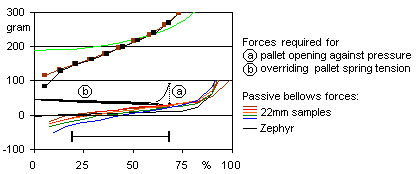 The point of interest is what force is required from the
bellows. The point of interest is what force is required from the
bellows.
a is the force to
open the pallet against the air pressure. This applies only when the
pallet is closed and decreases rapidly as the pallet opens. As computed
from the
dimensions of the pallet and its armature, at the pressure used here
this force would be 50-70 grams.
b
is the force from the pallet closing spring. The diagram shows
measurements from four samples, where the force refers to the bellows
maneuver tab. This
force has two essential characteristics. One is the spring constant,
the slope of the line, how much force increases with extension.
This depends on the length and diameter of the spring wire. The other
is the bias, coming from how the spring is bent for pre-tensioning at
its installation. The
bias determines the vertical position of the characteristic in the
diagram.
The characteristic of necessary force is the sum of a and b and must fit in between the upper
active
and lower passive curves of the force the bellows can supply. It
appears there is an ample safety margin what concerns the active
bellows force. With some of the stiffer covering materials one might
have to bend out the spring wires to increase the bias, such that the
bellows is reliably opened and the pallet closed. This is easily
checked at installation.
|
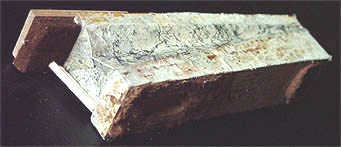 Original Zephyr
covered bellows, with black dust
accumulations in creases and cracks. (22x90 mm, a smaller one than
those measured)
Original Zephyr
covered bellows, with black dust
accumulations in creases and cracks. (22x90 mm, a smaller one than
those measured)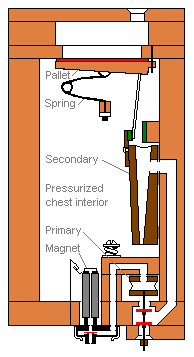 General layout of the note action inside the Wurlitzer
windchest. (Adapted from D L Junchen: The
Wurlitzer organ. ATOS 2005. ISBN 0-9763338-0-5)
General layout of the note action inside the Wurlitzer
windchest. (Adapted from D L Junchen: The
Wurlitzer organ. ATOS 2005. ISBN 0-9763338-0-5)
 The point of interest is what force is required from the
bellows.
The point of interest is what force is required from the
bellows. 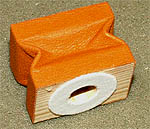 A similar measurement was made on one of
the small
primary bellows, covered with the Å&L tan leather.
A similar measurement was made on one of
the small
primary bellows, covered with the Å&L tan leather.